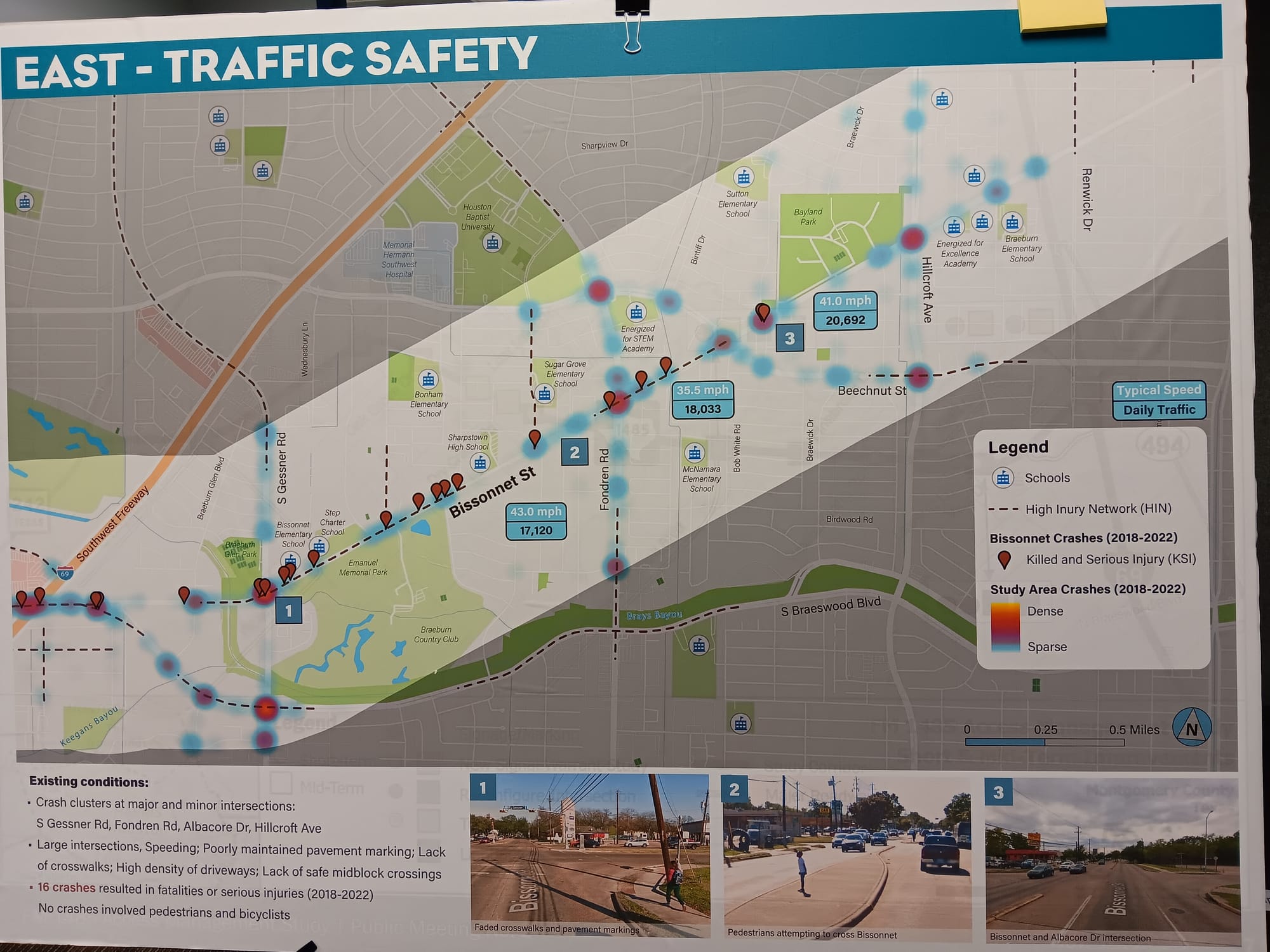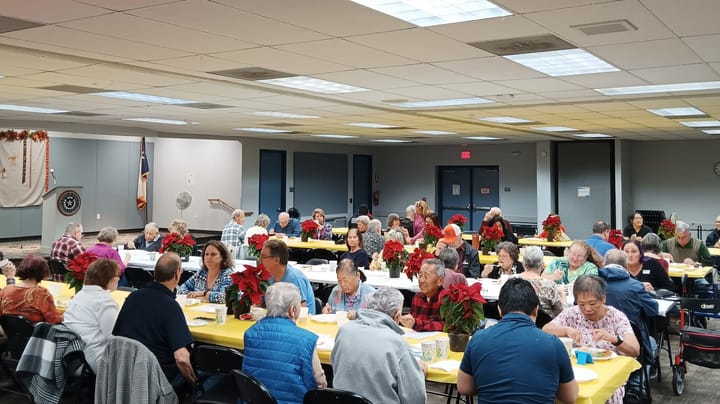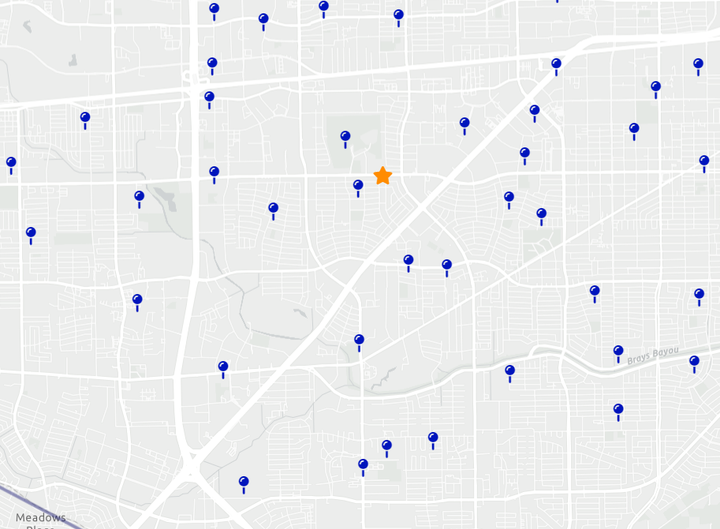Setting the Record Straight about the Bissonnet Safe Streets Project

Michael Berlinghof says the most dangerous part of his regular bike ride is the last twenty feet. When he tows a trailer behind his bicycle from his Robindell home to the grocery store, he must cross Bissonnet St.
Residents along a seven-mile stretch of Bissonnet (Hillcroft to Dairy Ashford) say that speeding and red-light-running are rampant. That stretch of Bissonnet had 3012 crashes—68 of them KSI (killed-or-serious-injury) crashes—from 2018-2022, according to data collected by Houston Public Works. HPW wants to address those problems through the Bissonnet Corridor Safe Streets Project.



Houston Public Works' visual traffic safety data for the three sections of Bissonnet St covered by the project. Red map pins represent KSI crashes, and red heat maps represent the density of crashes in general.
But how? That’s the kicker, and it had Bayland Community Center buzzing with heated questions and comments last night over residents’ fears that the project would actually make their neighborhoods less safe.
One source of fuel for the controversy? The federal grant application signed by Mayor Turner in September 2022 included a concept drawing of “road diet.”

For the section of Bissonnet between 59 and Beltway 8, the concept drawing reimagined the street shrinking from three regular traffic lanes each way to two each way. The grant application mentions that at least four other sections could be put on a similar “road diet”: Gessner to Braeburn Valley Dr, Braeburn Valley Dr to Fondren, Fondren to Beechnut, and Beechnut to Hillcroft.

At the meeting, Maplewood Civic Club president Phil Kunetka said that if traffic backs up on Bissonnet due to lane shrinkage, drivers will start cutting through his neighborhood.
Braeburn Super Neighborhood president Gena Sylvester echoed his concern. "We already have streets that have so much cut-through traffic that we're blocking off streets."
It didn’t help that Kunetka and Sylvester hadn’t been notified of a project stakeholder meeting last week, they said.
In response, HPW planner manager Donald Buaku said there must have been an email error and apologized that they were not notified.
More importantly, Buaku said that the concepts in the grant application were just that—concepts. "We do not have any plan or design. We will come up with one together."
The project is currently in the Design Concept Report (DCR) phase until August. Once HPW finishes the DCR based on community engagement, the engineering drawing phase will take roughly two years to come up with a final design, said Buaku. He hopes to begin construction in August 2026 and finish in August 2028.
Buaku was clear that HPW wants to create a design based on community feedback, and his team doesn't have to stick to the concepts in the grant application. But the original philosophy behind the project primarily focused on boosting safety by slowing car traffic and making Bissonnet more pedestrian-friendly.
The grant writers mentioned a variety of options, especially widening sidewalks and narrowing traffic lanes from 12' wide to 10' wide (11' at most). But eliminating some lanes altogether was being entertained as an option.

How likely is road diet to happen—and what about the other strategies listed above? Time will tell. Right now, HPW staff say they want input from residents. But whose input will HPW follow?
Many residents at the meeting, including Kunetka and Sylvester, were dead set against any traffic lane reductions. A vocal man wearing a blue shirt asked why the city didn't just spend the money on more police officers to enforce traffic laws.
But others, like Berlinghof and a young man near the front, believed that the current design of Bissonnet is flawed and encourages speeding. Berlinghof wouldn't mind bigger changes to the road if they improved biking and mass transit in the area.
Interestingly, both Berlinghof and Sylvester suggested rail transit running down the median, but that’s not mentioned in the grant (and would likely cost more than the project's estimated $35.9 million price tag).
But the grant does mentions that some intersections, like Bissonnet and South Braeswood, may be turned into roundabouts. Berlinghof is in favor of roundabouts—he says they reduce crashes and are common in Europe, where he originally lived.
What about getting more officers on the streets? That's not covered in this infrastructure project, but it is one of Mayor John Whitmire's priorities. But HPD Officer Loc Tram said that this particular area of Southwest Houston is challenging for HPD because of its high population density. "We're not going to ticket our way out of it."
Most residents would probably agree with Tram on one thing: "We need to come up with a solution we can all buy in on."
Learn about another transportation project planned for Southwest Houston. It could involve reducing traffic lanes on Hillcroft.





Comments ()